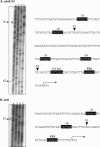Expression of abrB310 and SinR, and effects of decreased abrB310 expression on the transition from acidogenesis to solventogenesis, in Clostridium acetobutylicum ATCC 824
- PMID: 15812030
- PMCID: PMC1082569
- DOI: 10.1128/AEM.71.4.1987-1995.2005
Expression of abrB310 and SinR, and effects of decreased abrB310 expression on the transition from acidogenesis to solventogenesis, in Clostridium acetobutylicum ATCC 824
Abstract
The transcription factors sinR and abrB are involved in the control of sporulation initiation in Bacillus subtilis. We identified a single homologue to sinR and three highly similar homologues to abrB, designated abrB310, abrB1941, and abrB3647, in Clostridium acetobutylicum ATCC 824. Using reporter vectors, we showed that the promoters of abrB1941 and abrB3647 were not active under the growth conditions tested. The abrB310 promoter was strongly active throughout growth and exhibited a transient elevation of expression at the onset of solventogenesis. Primer extension assays showed that two transcripts of abrB310 and a single, extremely weak transcript for sinR are expressed. Potential -35 and -10 consensus motifs are readily identifiable surrounding the transcription start sites of abrB310 and sinR, with a single putative 0A box present within the promoter of abrB310. In strains of C. acetobutylicum transformed with plasmids to elevate sinR expression or decrease sinR expression, no significant differences in growth or in acid or solvent production were observed compared to the control strains. In C. acetobutylicum strain 824(pAS310), which expressed an antisense RNA construct targeted against abrB310, the acids acetate and butyrate accumulated to approximately twice the normal concentration. This accumulation corresponded to a delay and decrease in acetone and butanol production. It was also found that sporulation in strain 824(pAS310) was delayed but that the morphology of sporulating cells and spores was normal. Based upon these observations, we propose that abrB310 may act as a regulator at the transition between acidogenic and solventogenic growth.
Figures





References
-
- Awang, G. M., G. A. Jones, and W. M. Ingledew. 1988. The acetone-butanol-ethanol fermentation. Crit. Rev. Microbiol. 15(Suppl. 1):S33-S67. - PubMed
-
- Bai, U., I. Mandic-Mulec, and I. Smith. 1993. SinI modulates the activity of SinR, a developmental switch protein of Bacillus subtilis, by protein-protein interaction. Genes Dev. 7:139-148. - PubMed
-
- Benson, L. M., J. L. Vaughn, M. A. Strauch, B. G. Bobay, R. Thompson, S. Naylor, and J. Cavanagh. 2002. Macromolecular assembly of the transition state regulator AbrB in its unbound and complexed states probed by microelectrospray ionization mass spectrometry. Anal. Biochem. 306:222-227. - PubMed
Publication types
MeSH terms
Substances
Associated data
- Actions
- Actions
- Actions
- Actions
- Actions
- Actions
- Actions
LinkOut - more resources
Full Text Sources
Other Literature Sources
Molecular Biology Databases

